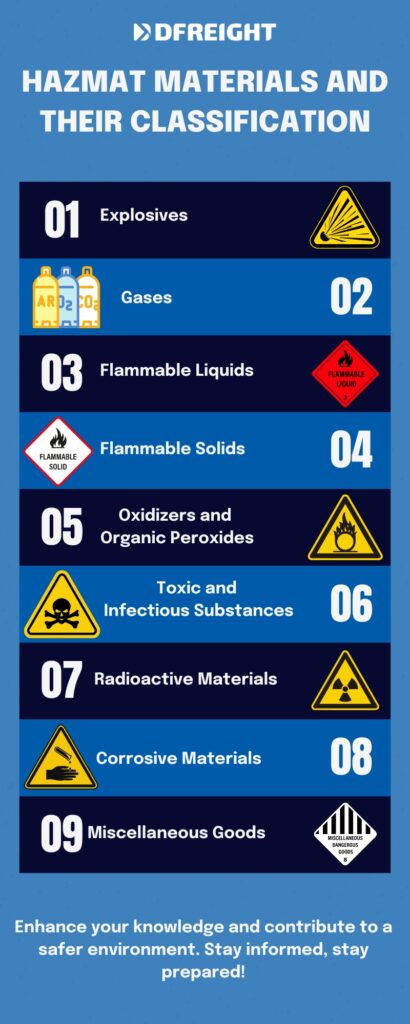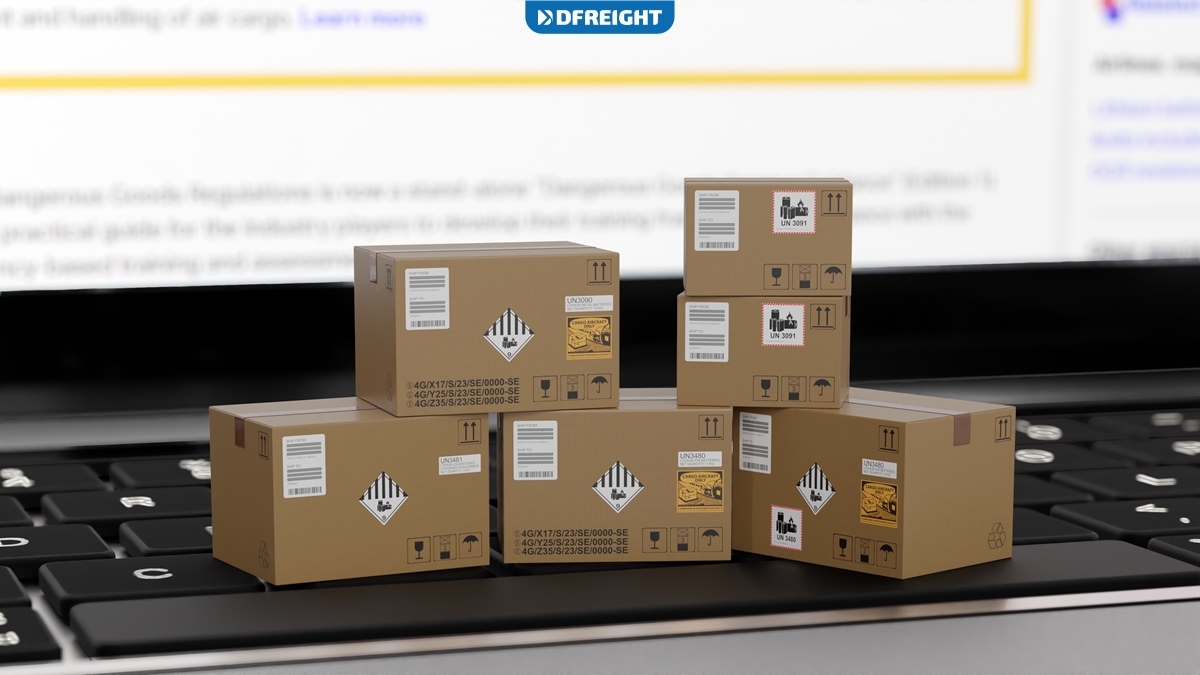Hazmat shipping is a complex and regulated process that involves transporting hazardous materials safely. One crucial aspect of hazmat transportation is the use of shipping papers, which provide vital information about the nature of the hazardous materials being transported. In this ultimate guide, we will delve into the world of hazmat shipping papers and equip you with the knowledge to ensure safe and compliant transport.
Are you shipping hazardous materials and need a reliable digital freight forwarding solution? Look no further than DFreight, your trusted partner for hazmat shipping. Experience the convenience of our digital platform, tailored specifically for hazmat transportation. From accurate documentation to compliance with regulations, we’ve got you covered. Simplify your hazmat shipping process today and ensure safe, compliant transport with DFreight. Take the leap towards a smarter, faster, and more reliable shipping experience. Get started with DFreight now!
Table of Contents
The Basics of Hazmat Shipping Papers
To understand hazmat shipping papers, we need first to grasp their definition and purpose. Hazmat shipping papers are documents that accompany hazardous materials during transportation. They serve as a means of communication between the shipper, carrier, and consignee, providing essential details about the contents of the shipment and necessary precautions.
In a world where hazardous materials (hazmat) play a vital role in various industries, it becomes imperative to ensure their safe shipping. Hazmat shipping papers serve as essential documents in this process, providing crucial information to carriers, handlers, and emergency responders. Let’s explore the definition and purpose of hazmat shipping papers, highlights their key components and required information, and delve into common hazmat classes and their identification numbers.
Definition and Purpose of Hazmat Shipping Papers
Hazmat shipping papers, also known as dangerous goods declarations or bills of lading, are official documents required for the transportation of hazardous materials. These papers accompany hazardous shipments throughout their journey, providing a comprehensive overview of the materials being transported and the necessary safety precautions. Their primary purpose is to ensure the safe handling, storage, and transportation of hazardous materials while enabling proper emergency response in case of incidents.
Key Components and Required Information
Hazmat shipping papers consist of several key components and required information to identify and handle hazardous materials accurately. The following elements are typically included:
- Shipper’s Information: This section contains the name, address, and contact details of the entity responsible for shipping the hazardous materials.
- Consignee’s Information: The recipient’s details are provided to ensure proper delivery and communication.
- Carrier’s Information: This section includes the carrier’s name, address, and contact information responsible for transporting the hazardous materials.
- Description of Materials: A detailed description of the hazardous materials being shipped is vital. It includes the proper shipping name, hazard class, identification number, and packing group.
- Quantity and Packaging: The number of hazardous materials and their specific packaging details, such as the number of containers, dimensions, and type of packaging, are indicated in this section.
- Emergency Response Information: Hazmat shipping papers must contain emergency response instructions and contact information, allowing prompt action in case of accidents, spills, or other incidents.
- Special Handling Instructions: If any special handling instructions are necessary for the safe transportation of hazardous materials, they must be clearly outlined.
Common Hazmat Classes and Their Identification Numbers
Hazmat materials are classified into several categories based on their properties and potential risks. The hazard class indicates the type of danger posed by the material, while the identification number uniquely identifies the substance. Here are some of the common hazmat classes and their identification numbers:

- Class 1: Explosives (e.g., fireworks, ammunition) – Identification Numbers: 1.1 to 1.6.
- Class 2: Gases (e.g., propane, oxygen) – Identification Numbers: 2.1 (flammable gas), 2.2 (non-flammable compressed gas), 2.3 (poisonous gas).
- Class 3: Flammable Liquids (e.g., gasoline, ethanol) – Identification Number: 3.
- Class 4: Flammable Solids (e.g., matches, sulfur) – Identification Numbers: 4.1 (flammable solid), 4.2 (spontaneously combustible material), 4.3 (dangerous when wet material).
- Class 5: Oxidizers and Organic Peroxides (e.g., hydrogen peroxide, ammonium nitrate) – Identification Numbers: 5.1 (oxidizer), 5.2 (organic peroxide).
- Class 6: Toxic and Infectious Substances (e.g., pesticides, infectious substances) – Identification Numbers: 6.1 (toxic substance), 6.2 (infectious substance).
- Class 7: Radioactive Materials (e.g., uranium, medical isotopes) – Identification Number: 7.
- Class 8: Corrosive Materials (e.g., sulfuric acid, sodium hydroxide) – Identification Number: 8.
- Class 9: Miscellaneous Hazardous Materials (e.g., asbestos, lithium batteries) – Identification Number: 9.
Understanding common hazmat classes and their identification numbers further aids in accurately identifying and handling hazardous materials. Through the meticulous use of hazmat shipping papers, we can minimize the risks associated with the transportation of dangerous goods and foster a safer environment for all.
Legal Requirements and Regulations
The transportation of hazardous materials (hazmat) is a critical aspect of modern society. In the United States and internationally, several regulatory bodies have established legal requirements for the transportation of hazmat.
Overview of Relevant Hazmat Regulations
The transportation of hazardous materials is subject to various regulations that aim to minimize risks associated with handling, storage, and transportation. In the United States, the primary regulatory authority for hazmat transportation is the Department of Transportation (DOT). The DOT’s Pipeline and Hazardous Materials Safety Administration (PHMSA) administers and enforces regulations outlined in Title 49 of the Code of Federal Regulations (49 CFR), specifically parts 100-185. These regulations cover various aspects of hazmat transportation, including classification, packaging, marking, labeling, placarding, and documentation.
On an international level, the International Air Transport Association (IATA) and the International Maritime Organization (IMO) have established regulations governing the transportation of hazardous materials by air and sea, respectively. The IATA’s Dangerous Goods Regulations (DGR) provide guidelines for the safe transportation of hazmat by air carriers. The DGR outlines classification, packaging, marking, labeling, and documentation requirements specific to air transportation. Similarly, the IMO’s International Maritime Dangerous Goods (IMDG) Code sets forth regulations for the safe transportation of hazmat by sea. The IMDG Code covers areas such as classification, packaging, stowage, segregation, and documentation for maritime transportation.
Understanding the Responsibilities of Shippers, Carriers, and Consignees
Shippers, carriers, and consignees play crucial roles in ensuring compliance with hazmat regulations. Shippers are responsible for properly classifying hazardous materials, selecting appropriate packaging, marking and labeling packages, preparing shipping papers, and providing emergency response information. They must also train their employees adequately and maintain records of training.
Carriers, including air and ocean carriers, are responsible for ensuring that they transport hazmat in compliance with applicable regulations. This includes verifying that packages are properly labeled, marked, and documented and that necessary placards or labels are affixed to transport vehicles or containers. Carriers must also ensure that their employees are trained in hazmat handling and emergency response procedures.
Consignees, who receive hazmat shipments, have a responsibility to inspect packages for compliance with applicable regulations upon receipt. They must promptly report any discrepancies or non-compliance issues to the appropriate authorities and take necessary measures to ensure the safe handling and storage of hazmat.
Penalties and Consequences for Non-Compliance
Non-compliance with hazmat regulations can have severe consequences. Regulatory authorities, such as the DOT, have the power to impose penalties for violations, ranging from fines to criminal charges. Penalties can vary depending on the nature and severity of the violation, previous compliance history, and potential harm caused by non-compliance.
Apart from legal penalties, non-compliance with hazmat regulations can result in significant safety hazards, including accidents, injuries, and environmental damage. Mishandling or improper transportation of hazmat can lead to fires, explosions, toxic releases, and contamination of air, water, and soil.
Additionally, non-compliance can have reputational consequences for organizations involved in hazmat transportation. Violations can lead to public scrutiny, loss of trust, and damage to a company’s brand image. This can result in financial losses and long-term repercussions for the business.
It is crucial for all stakeholders involved in hazmat transportation to prioritize compliance, invest in proper training, and adhere to best practices to protect human health, the environment, and the integrity of their operations.
Creating and Completing Hazmat Shipping Papers
Shipping hazardous materials (hazmat) requires careful adherence to regulatory guidelines and documentation. Hazmat shipping papers play a crucial role in ensuring the safe transport of dangerous goods. Here we provide a step-by-step guide to help you create and complete hazmat shipping papers, focusing on essential information such as proper shipping names, hazard classes, and packaging requirements.
- Familiarize Yourself with Regulatory Requirements: Before embarking on the hazmat shipping paper preparation process, it is essential to understand and comply with relevant regulations. These regulations outline the guidelines for packaging, marking, labeling, and documentation of hazardous materials during transportation.
- Gather Essential Information: To complete hazmat shipping papers accurately, you must collect the necessary information. This includes the proper shipping name, hazard class, identification number, packing group, quantity, and packaging type for each hazardous material being shipped. Consult the material safety data sheet (MSDS) or Safety Data Sheet (SDS) for each substance to ensure accurate classification and identification.
- Determine Proper Shipping Names: Proper shipping names are standardized names assigned to hazardous materials for transport purposes. Refer to the Hazardous Materials Table (HMT) found in the HMR to identify the proper shipping names for the substances you are shipping. The HMT provides a comprehensive list of hazardous materials along with their associated identification numbers and hazard classes.
- Determine Hazard Classes and Packaging Groups: Hazard classes categorize hazardous materials based on their predominant hazards, such as flammability, toxicity, or corrosiveness. Each hazard class has specific packaging requirements. Refer to the HMT to determine the appropriate hazard class and packaging group for each hazardous material. The packaging group indicates the level of protection required during transportation, with higher groups requiring more robust packaging.
- Calculate Quantity and Packaging Type: Accurately determine the quantity of hazardous material being shipped and select the appropriate packaging type. Packaging types may include drums, boxes, cylinders, or specialized containers designed for specific hazards. Ensure that the selected packaging type complies with the regulations and provides adequate protection during transportation.
- Complete the Shipping Paper: Using the information gathered, complete the hazmat shipping paper. The shipping paper should include the proper shipping name, hazard class, identification number, packing group, quantity, packaging type, and other relevant details. Include any required emergency response information and special handling instructions if applicable.
- Packaging and Marking Requirements: To ensure compliance with regulations, packaging must be done according to the specified requirements. Use appropriate packaging materials that are compatible with the hazardous material being shipped. Label the packaging with the appropriate hazard labels, markings, and placards, as per the regulations. The labels and markings should clearly indicate the hazard class, identification number, and other necessary information.
Creating and completing hazmat shipping papers is a crucial step in the safe transportation of hazardous materials. By following this step-by-step guide, which includes gathering essential information, determining proper shipping names, hazard classes, and packaging groups, and completing the shipping paper accurately, you can ensure compliance with regulations and guarantee the safety of all involved parties.
Key Takeaways
Hazmat shipping papers are a critical component of hazmat transportation, providing crucial information about hazardous materials being transported. Compliance with hazmat shipping regulations is essential to ensure the safety of everyone involved and prevent potential incidents. By adhering to best practices, staying informed about regulations, and creating accurate shipping papers, you can contribute to safe and compliant hazmat transport.
What are Hazmat Shipping Papers?
Hazmat Shipping Papers, also known as hazardous materials shipping papers or dangerous goods documentation, are legal documents required by regulatory authorities for the transportation of hazardous materials. These papers provide detailed information about the nature, classification, and handling instructions of the hazardous materials being shipped.
Why are Hazmat Shipping Papers necessary?
Hazmat Shipping Papers are necessary to ensure the safe and compliant transportation of hazardous materials. They serve as a communication tool between shippers, carriers, and emergency responders, providing critical information about the potential hazards of the materials being transported, as well as guidance on proper handling, storage, and emergency response procedures.
What information is included in Hazmat Shipping Papers?
Hazmat Shipping Papers contain essential information about the hazardous materials being shipped, such as the proper shipping name, UN/NA identification number, hazard class, packaging type, quantity, and packaging instructions. They also include emergency contact details, special handling instructions, and any necessary permits or certifications.
Who is responsible for preparing Hazmat Shipping Papers?
The shipper, who is usually the entity sending the hazardous materials, is responsible for preparing the Hazmat Shipping Papers. They must accurately complete the required information and ensure compliance with applicable regulations, including proper classification, packaging, and labeling of the hazardous materials.














